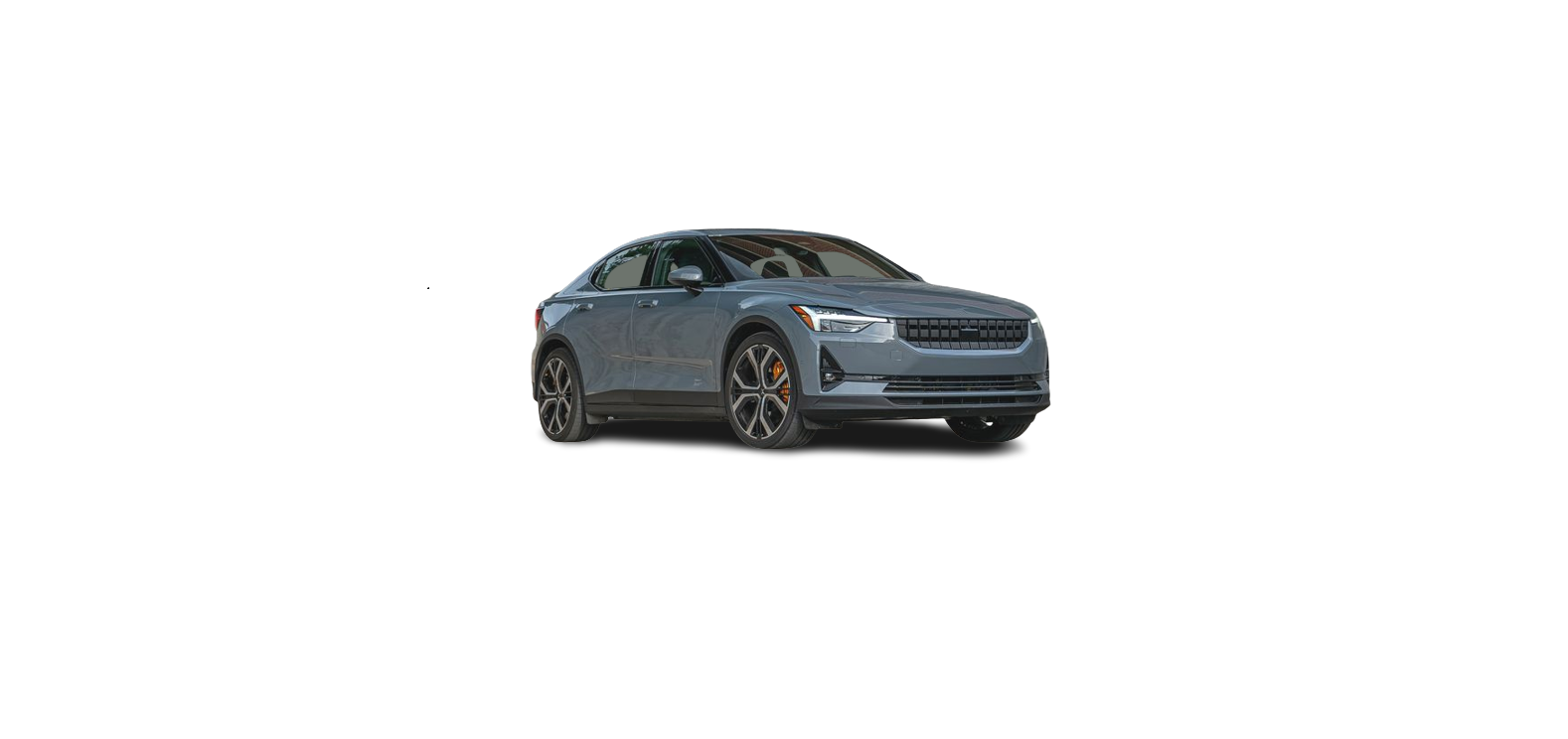2021 Polestar 2 Charging of high-voltage battery
Charge cable
The charging cable is used to charge the vehicle’s high-voltage battery. The charging cable is designed to satisfy Polestar’s safety standard. Use a charging cable recommended by Polestar, thereby guaranteeing its function and safety. Polestar accepts no responsibility for safety or any injury caused by a charging cable that is not recommended by Polestar.
| Specifications, charging cable | |
|---|---|
| Enclosure class
Compliance |
IP67
SAE J1772 |
| Ambient temperature | –32 ºC to 50 ºC (-25 ºF till 122 ºF) |
- The charging cable must be grounded when in use. It is equipped with a cord with a grounding conductor and a grounding plug. The plug must be inserted into an appropriate outlet that is properly installed and grounded in accordance with all local codes and ordinances and is not damaged in any way.
- Children should be supervised when in the vicinity of the charging cable when it is plugged in.
- High voltage is present in your electric meter housing and power distribution service panel. Contact with high voltage can cause death or serious personal injury.
- Do not use the charging cable if it is damaged in any way. Damaged or malfunctioning charging cables may only be repaired by a workshop – contact Polestar Customer Support for more information.
- Always position the charging cable so that it will not be driven over, stepped on, tripped over or otherwise damaged, or cause personal injury.
- Disconnect the charger from the wall outlet before cleaning it.
- Never connect the charging cable to an extension cord or a multiple plug socket.
- Do not use any adapters between the charging cable and electrical outlet.
- Do not use an external timer between the charging cable and electrical outlet.
Also, refer to the manufacturer’s instructions for using the charging cable and its components.
Power strips, extension cords, surge protectors or similar devices must not be used together with the charging cable since this may involve a risk of fire, electric shocks, etc.
An external timer or adapter may not be used between the 120/240 V outlet (AC, alternating current) and the charging cable.
Never detach the charging cable from the 120/240 V outlet (AC, alternating current) while charging is in progress – the 120/240 V outlet could be damaged in such circumstances. Always interrupt charging first and then disconnect the charging cable – first from the vehicle’s charging socket and then from the 120/240 V outlet.
Wipe the charging cable with a clean cloth lightly moistened with water or a mild detergent. Do not use chemicals or solvents.

The charging cable and its components must not be rinsed or immersed in water.
Avoid exposing the charging module and its plug to direct sunlight. In such cases, the overheating protection in the plug could reduce or cut off charging of the high-voltage battery.
Charging in vehicle’s center display
Setting charge level
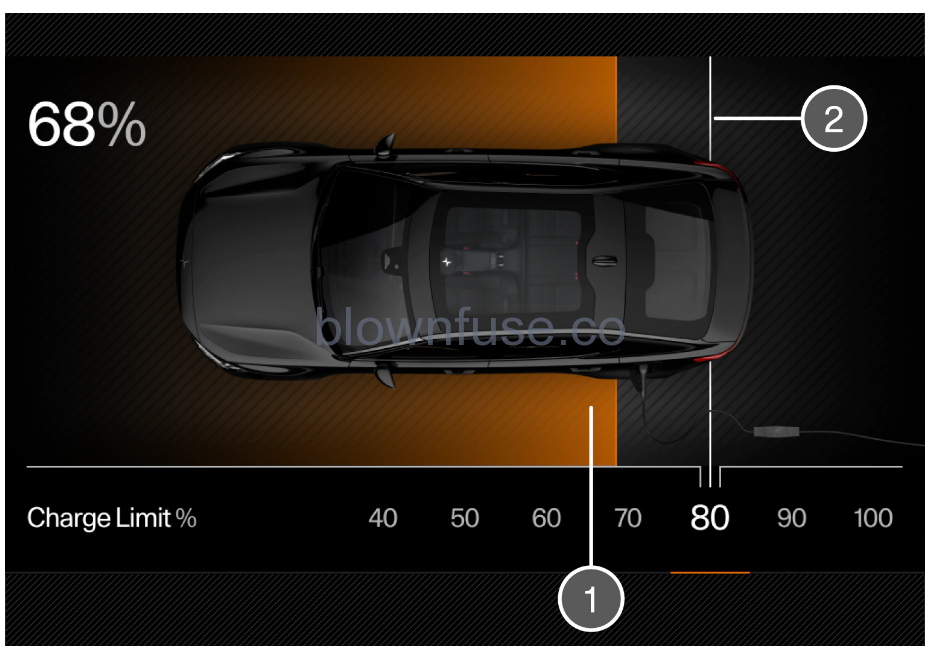
- Current charge status of battery.
- Swipe to set desired charge level. The charge level will remain the same until the next time, unless it is changed in the center display.
Unlocking the charging cable
Tap ![]() in the center display to cancel charging. Charging will stop when the charging cable is unlocked.
in the center display to cancel charging. Charging will stop when the charging cable is unlocked.
Setting amperage
When charging using alternating current, the plus and minus signs can be used to adjust amperage. The amperage currently used for charging is shown in the center display.
Charging of high-voltage battery
The high-voltage battery is charged using a charging cable.
The battery can also be charged at charging stations using the integrated charge module. The charging stations can be equipped with either a fixed charging cable or a socket in which a special charging cable with a matching connector (a mode 3 charging cable) can be plugged in.
Rapid charging
In addition to charging via a 120/240 V outlet (alternating current), the vehicle also supports direct-current rapid charging at charging stations supporting the CCS (Combined Charging System) standard. Charging with direct current usually enables higher charging output and thereby shorter charging times. The highest charging output is normally achieved when the charge level of the high-voltage battery is 0-80%. When the charge level rises, the output will be decreased to reduce wear.
California Proposition 65
Operating, servicing and maintaining a passenger vehicle can expose you to chemicals including engine exhaust, carbon monoxide, phthalates, and lead, which are known to the State of California to cause cancer and birth defects or other reproductive harm. To minimize exposure, avoid breathing exhaust, do not idle the engine except as necessary, service your vehicle in a well ventilated area and wear gloves or wash your hands frequently when servicing your vehicle. For more information go to www.P65Warnings.ca.gov/passenger-vehicle.
Polestar recommends a charging cable according to SAE J1772 that supports temperature monitoring.
The electrical system in your vehicle uses high-voltage electrical current. Any damage to this system or to the high-voltage battery may result in the danger of overheating, fire, or serious injury. If the vehicle is involved in a collision or exposed to flooding, fire, etc., contact Polestar Customer Support. Prior to this inspection, the vehicle should be parked outdoors at a safe distance from any building or potentially flammable materials.
The charging time for the high-voltage battery depends on the charging output used.
The capacity of the high-voltage battery decreases somewhat with age and use.
If the high-voltage battery needs to be replaced, contact Polestar Customer Support.
Charging cable handle and charging socket
Charging cable handle and charging socket.
Charging status is indicated in the following ways:
- Indicator on the charging cable’s control module.
- Indicator light in the vehicle’s charging socket.
- Images and text in the instrument panel.
The 12 V battery is charged while the high-voltage battery is charging and stops charging when the high-voltage battery is fully charged. The vehicle cannot be driven while it is being charged.
The high-voltage battery may have reduced performance if the temperature in the batteries is too low or too high.
Leaving the vehicle for prolonged periods at temperatures under –10 °C (14 °F) or over 40 °C (104 °F) may reduce the performance of the high-voltage battery. Plug in the vehicle to charge to help prevent the battery from becoming too hot or too cold.
Charging output
Polestar strongly advises against charging the vehicle with alternating current of 100-120 V in combination with an amperage under 10A.
When the charging cable is activated, a message will be displayed in the instrument panel and an indicator light in the vehicle’s charging socket will illuminate. The vehicle’s center display is activated at the same time and shows the charging settings. Charging output is primarily used for battery charging, but is also used for preconditioning. The 12 V battery is charged while the vehicle’s batteries are charging.
Never detach the charging cable from the 120/240 V outlet (AC, alternating current) while charging is in progress – the 120/240 V outlet could be damaged in such circumstances. Always interrupt charging first and then disconnect the charging cable – first from the vehicle’s charging socket and then from the 120/240 V outlet.
- In extremely cold or hot weather, part of the charging current is used to heat/cool the high-voltage battery and the passenger compartment, resulting in a longer charging time.
- The charging time is longer if preconditioning has been selected. The time required depends primarily on the ambient temperature.
- Rapid charging with up to 150 kW output is possible under favorable conditions for the high-voltage battery and the charging station. Charging output is limited toward the end of rapid charging.
Charging time (AC)
Charging time varies depending on the current strength set in the center display or available charging output. The following charging times apply when charging is not affected by current being drawn from the climate system or any other function. The charging time can also vary depending on battery size. If charging seems to be taking more time than shown in the table, this should be investigated.
|
Current (A) |
Charging output (kW) |
Charging time (hours) |
|---|---|---|
| 6 | 1.3 | 72 |
| 10 | 2.2 | 40 |
| 16 | 3.6 | 24 |
| 32 | 7.2 | 12 |
| 48 | 11 | 8 |
| Current (A) | Charging output (kW) | Charging time (hours) |
|---|---|---|
| 6 | 4 | 22 |
| 10 | 6.8 | 14 |
| 16 | 11 | 8 |
Charging time for rapid charging
|
Charging output (kW) |
Charging time (minutes) |
|---|---|
| 50 | 65 |
| 150 | 35 |
Fuse
There are normally several 120/240 V power consumers in one fuse circuit, which means that more than one power consumer (e.g. lighting, vacuum cleaner, electric drill, etc.) may use the same fuse.
Charging status in the charging cable’s control module
Control module with indicator
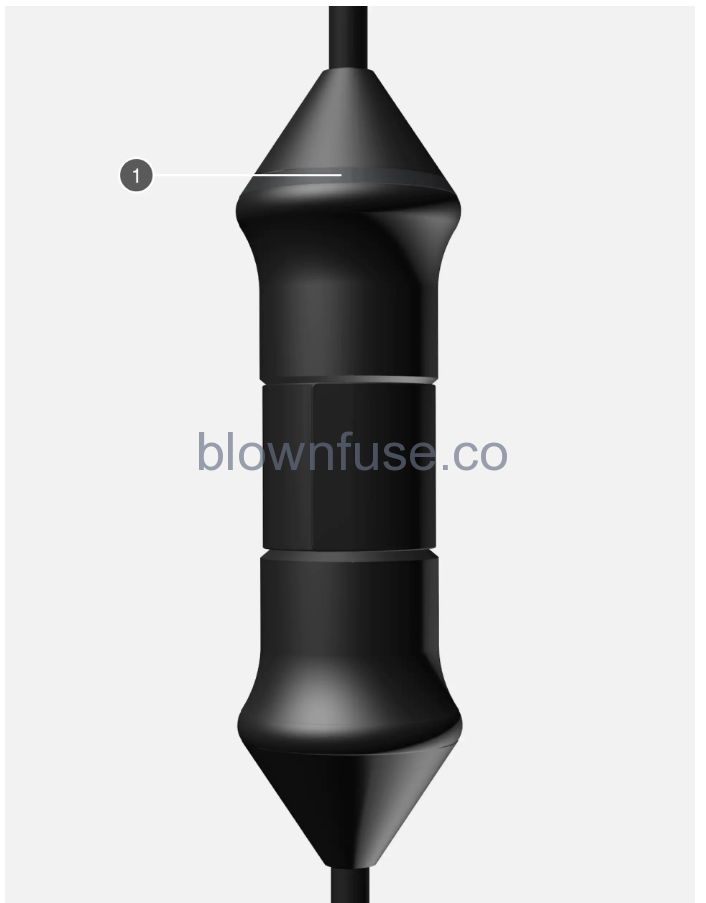
The control module’s LED indicator.
|
|
LED indicator |
| LED | Status | Meaning | Recommended action |
|---|---|---|---|
| Off | Charging is not possible. | No power supply to charging cable. |
|
| Steady white light | Charging possible. | The charging cable is ready to be plugged into the vehicle. |
If the LED indicator is white but charging is not possible:
|
| Flashing white light | Charging is in progress. | The vehicle’s electronic system has initiated charging.
Charging is in progress. |
Wait until the batteries are fully charged. |
| Steady red light | Charging is not possible. | Temporary fault. |
|
| Flashing red light | Charging is not possible. | Critical fault. | Unplug the charging cable from the outlet. If the problem persists, contact Polestar Customer Support. |
Charging status in the instrument panel
| Color | Status | Meaning |
|---|---|---|
| Flashing green | The instrument panel frame will appear with a green, pulsating light. | Charging is in progress and the approximate time at which the batteries will be fully charged is displayed. |
| Green | The instrument panel frame will appear with a steady green light. | The batteries are fully charged. |
| Red | The instrument panel frame will appear with a red, pulsating light. | Malfunction. Make sure the charging cable is correctly connected to the vehicle’s charging socket and to the 120/240 V outlet (alternating current). |
| Blue | The instrument panel frame will appear with a blue, pulsating light. | Scheduled charging activated. |
| Yellow | The instrument panel frame will appear with a yellow, pulsating light. | Charging is waiting to start or has been paused. |
If the instrument panel is not used, it will go dark after a period of time. To reactivate the display:
- depress the brake pedal,
- open one of the doors, or
- press any of the steering wheel keypad buttons.
Charging status in the vehicle’s charging socket
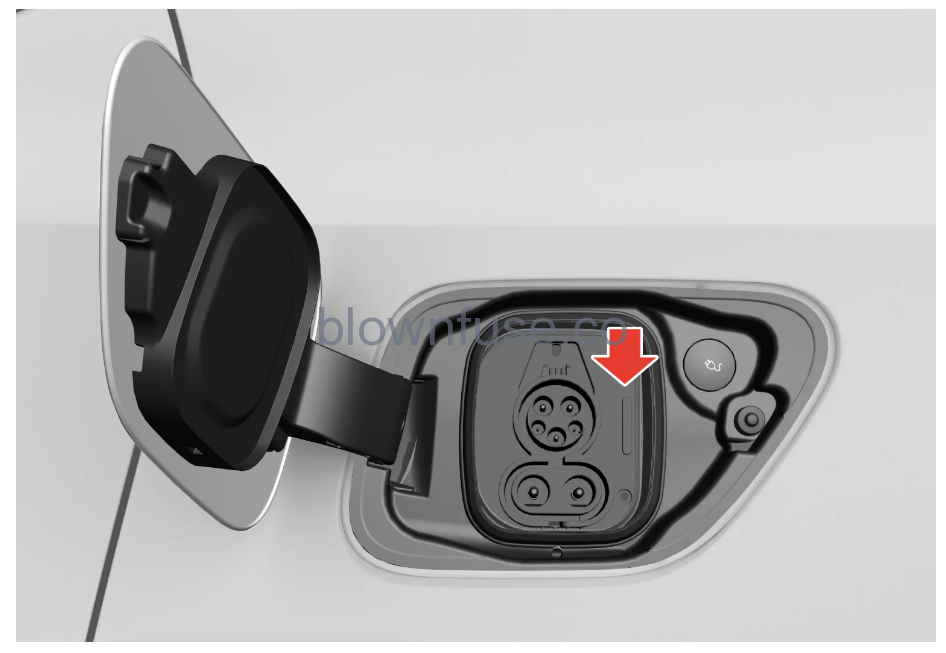
Location of the LED indicator light in the vehicle’s charging socket.
The LED indicator light shows the current charge status during charging. If the LED indicator light is not illuminated, check to make sure the cable is securely connected in the wall outlet and in the outlet in the vehicle. A white, red or yellow light illuminates when the passenger compartment lighting is activated and will remain illuminated for a short time after the passenger compartment lighting has gone out.
| LED indicator light’s color | Meaning |
|---|---|
| White |
Courtesy light |
| Yellow |
Wait mode – waiting for charging to start. |
| Flashing yellow | The charging process is being stopped. |
| Green |
Charging completed. |
| Flashing green |
Charging is in progress. |
| Red | Malfunction. |
| Blue | Scheduled charging activated. |
Electric propulsion symbols and messages in the instrument panel
| Symbol | Meaning |
|---|---|
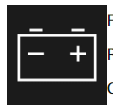 |
Fault in 12 V battery.
Read the message in the instrument panel. Contact Polestar Customer Support. |
 |
Fault in the drive system.
Read the message in the instrument panel. Contact Polestar Customer Support. |
 |
Temporary fault in driveline.
Read the message in the instrument panel. |
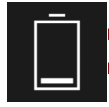 |
Information about the high-voltage battery’s charge level
Read the message in the instrument panel. |
Ground fault breaker in charging cable
The high-voltage battery may only be charged using grounded and approved 120/240 V outlets (AC, alternating current). If the electrical circuit or electrical socket’s capacity is not known, let a licensed electrician inspect the electrical circuit’s capacity. Using a charge level that exceeds the electrical circuit’s or electrical outlet’s capacity may start a fire or damage the electrical circuit.
- The charging cable’s residual current breaker helps protect the vehicle’s charging system but cannot ensure that an current overload will never occur.
- Never use visibly worn or damaged electrical sockets. Doing so could lead to fires or serious injury.
- Never connect the charging cable to an extension cord.
- Contact Polestar Customer Support for information on the maintenance or replacement of the high-voltage batteries.
- Only use the recommended charging cord.
- Do not use an external timer between the charging cord and the electrical outlet.
- Do not use any adapters between the charging cable and the electrical socket.
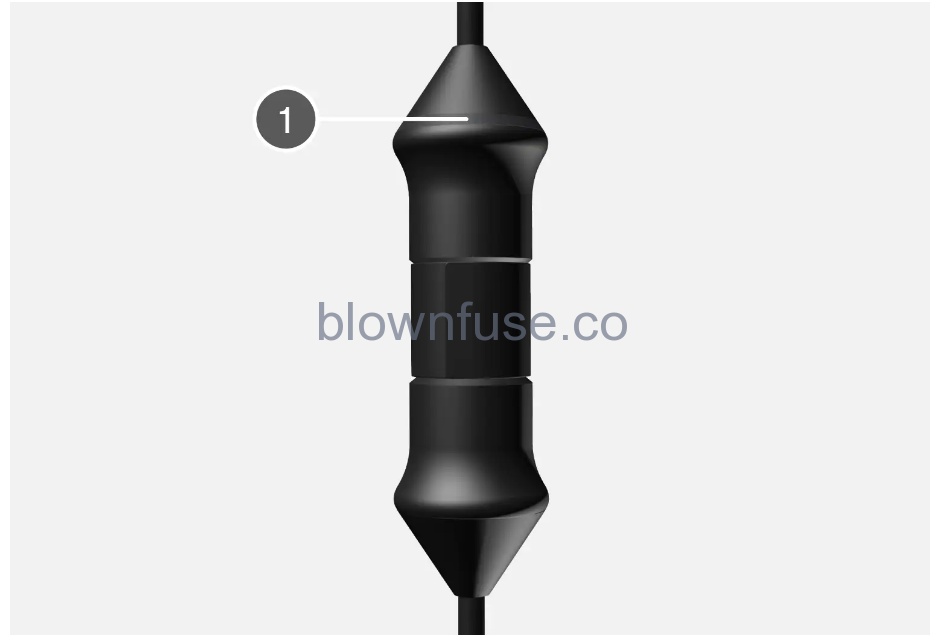
The control module’s LED indicator.
|
|
LED indicator |
If the charging cable’s ground fault breaker is tripped, the LED indicator will illuminate with a steady red glow. Have the outlet checked by a licensed electrician or try using another wall outlet.
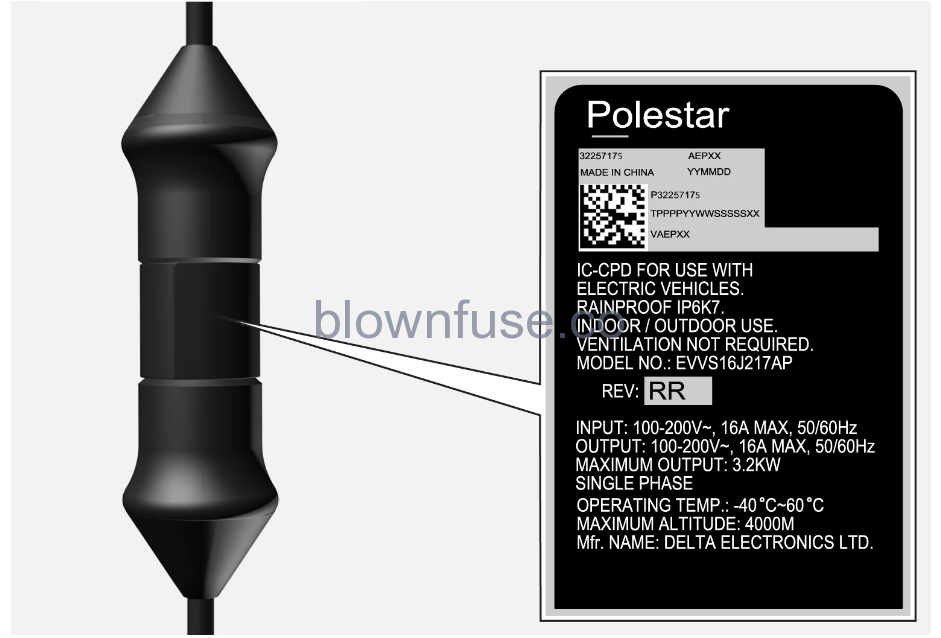
- Check the capacity of the socket.
- Other electronic equipment connected on the same fuse circuit must be disconnected if the total load is exceeded.
- Do not connect the charging cable if the socket is damaged.
Opening and closing the charging socket cover
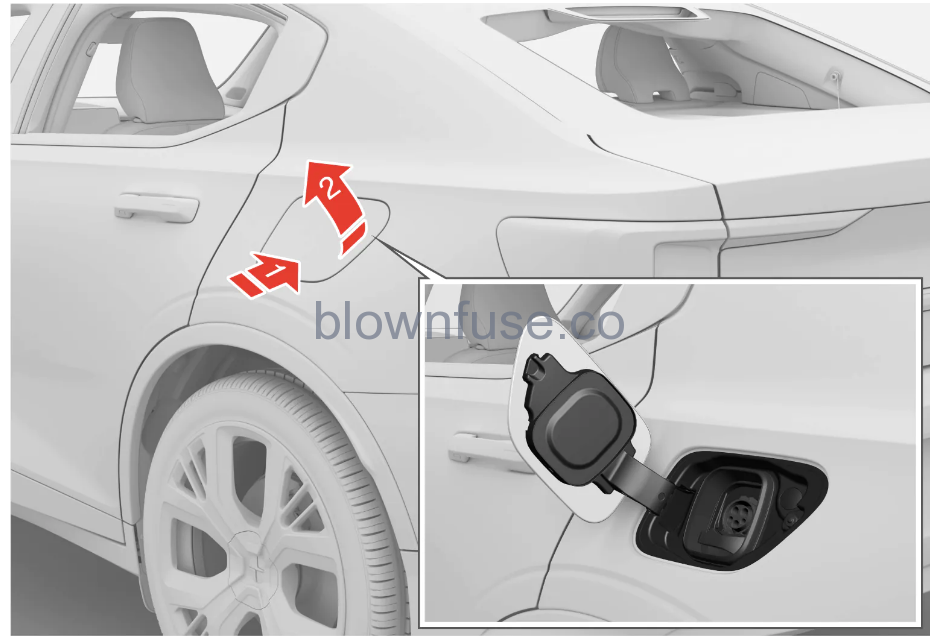
- Press in the rear edge of the charger door and release.
- Open the door.
Perform the following steps in reverse to close the charger door.
Starting charging of high-voltage battery
When charging using AC current, only use the charging cable provided with the vehicle or a replacement cable recommended by Polestar.
The vehicle’s high-voltage battery is charged using the charging cable between the vehicle and a 120/240 V outlet (alternating current) or charging station (mode 3).
Never connect the charging cable if there is a risk of a thunderstorm or there is lightning.
Polestar recommends a charging cable according to SAE J1772 that supports temperature monitoring.
- The charging cable must be grounded when in use. It is equipped with a cord with a grounding conductor and a grounding plug. The plug must be inserted into an appropriate outlet that is properly installed and grounded in accordance with all local codes and ordinances and is not damaged in any way.
- Children should be supervised when in the vicinity of the charging cable when it is plugged in.
- High voltage is present in your electric meter housing and power distribution service panel. Contact with high voltage can cause death or serious personal injury.
- Do not use the charging cable if it is damaged in any way.A damaged or malfunctioning charging cable may only be repaired by an authorized workshop. Contact Polestar Customer Support for more information.
- Always position the charging cable so that it will not be driven over, stepped on, tripped over or otherwise damaged, or cause personal injury.
- Disconnect the charger from the wall outlet before cleaning it.
- Never connect the charging cable to an extension cord or a multiple plug socket.
Also, refer to the manufacturer’s instructions for using the charging cable and its components.
Make sure that the 120/240 V outlet (AC, alternating current) has a power capacity sufficient for charging electric vehicles. If you are uncertain of the capacity, have the outlet checked by a licensed electrician. If you are unsure of the power capacity of the outlet, use the lowest power capacity in the center display.
Take out the charging cable. Note that the ignition must be switched off completely before charging.

-
Plug the charging cable into a 120/240 V outlet. Never use an extension cord.
Set the correct charging current (for that 120/240 V outlet) in the center display.
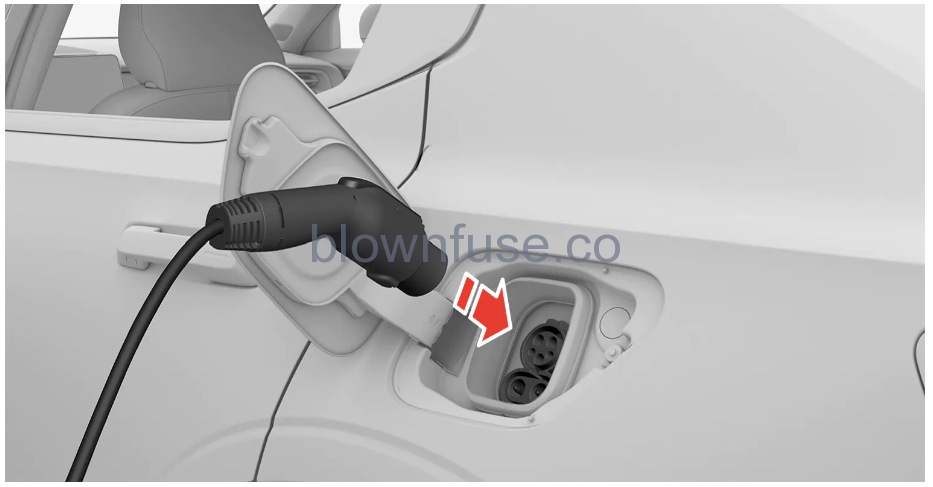
-
Open the charger door. Remove the charging cable’s protective cover and make sure there are no objects in the charging socket that could prevent charging.
Then push the handle all the way into the vehicle’s socket.
- The charging cable handle will lock into place and charging will begin within 5 seconds. When charging begins, the LED indicator in the charging socket will flash with a green light. The approximate remaining charging time or the charging status will be displayed in the instrument panel and the center display.
Battery charging can be temporarily interrupted by pressing the button near the charging socket. Charging will resume within a few minutes.
Never detach the charging cable from the 120/240 V outlet (AC, alternating current) while charging is in progress – the 120/240 V outlet could be damaged in such circumstances. Always interrupt charging first and then disconnect the charging cable – first from the vehicle’s charging socket and then from the 120/240 V outlet.
Rapid charging (direct current)
The vehicle’s high-volt batteries can be charged quickly using DC power at charging stations supporting the CCS (Combined Charging System) standard.
Charging stations supporting CCS are usually clearly marked CCS or Combo. Note that the vehicle must be switched off before charging.
Start rapid charging
- Remove the charging cable from the charging station’s storage socket.
- Open the charging socket cover and remove the charging socket cover.
-
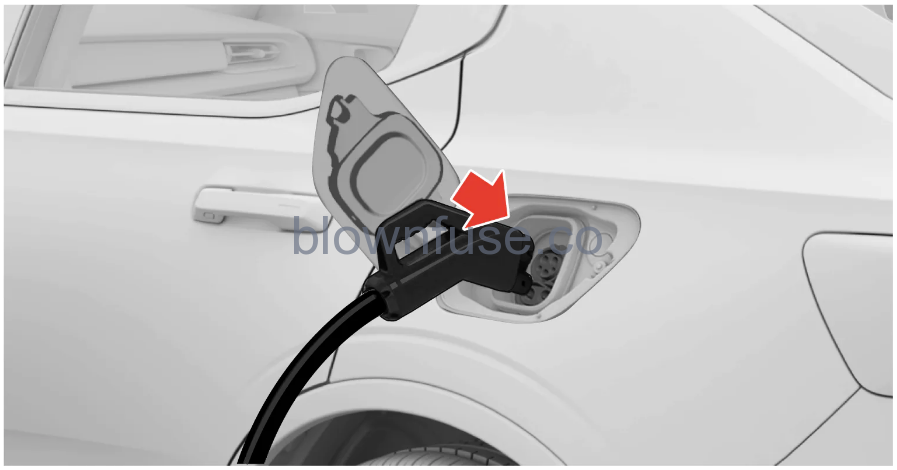
Grasp the charging cable with both hands and plug the charging cable all the way into the vehicle’s charging socket. The charging cable automatically locks into the charging socket after a few seconds. Make sure the charging cable locks fully into place so that charging can start.
- Follow the instructions in the charging station’s user interface to authorize the charging. Charging will begin after the charging station completes an insulation test. This may take a minute or so.
> When charging starts, the green LED light in the charging socket will begin to flash. The approximate remaining charging time or the charging status will be displayed in the instrument panel and the center display.
Rapid charging will not normally be interrupted if the vehicle is unlocked. Charging can be stopped by pressing the button next to the charging socket. Rapid charging cannot be resumed automatically if interrupted because the charging station will require reauthorization.
During charging, water from the air conditioning may condense and drip from underneath the vehicle. This is due to the cooling of the high-voltage batteries.
Stopping charging of high-voltage battery
Before the charging cable is removed from the vehicle’s charging socket, charging must be stopped by pressing the button next to the charging socket. This must be done even if the vehicle’s doors are already unlocked. If the vehicle is not unlocked, the charging cable or system may be damaged.
Always stop charging before unplugging the charging cable from the 120/240 V wall outlet (alternating current, AC) by pressing the button next to the vehicle’s charging socket or tapping the button in the center display. Note that the charging cable must be disconnected from the vehicle’s charging socket before it is disconnected from the 120/240 V outlet, partly to prevent damage to the system and party to prevent unintentional interruption of charging.
-
Stop charging using the button next to the charging socket.

-
Press the lock button on the charging cable’s handle. The handle will be released/unlocked. Unplug the cable from the vehicle’s charging socket and close the charger door.
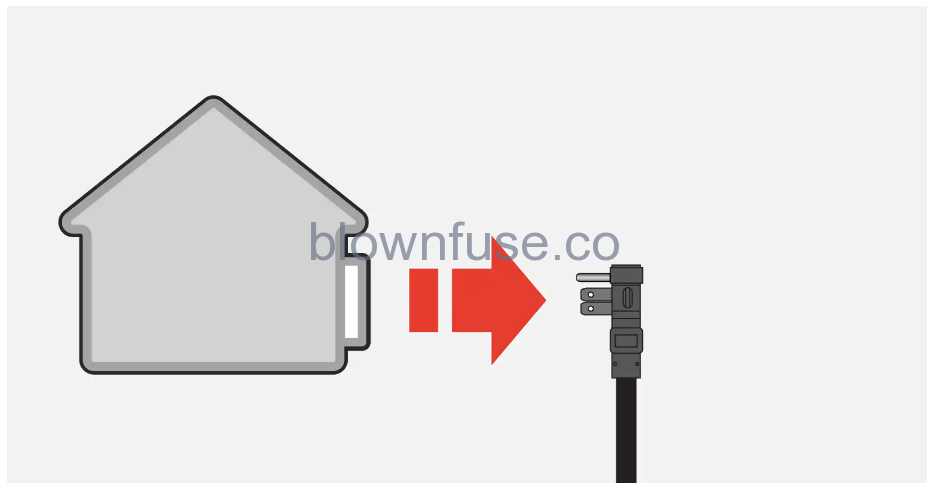
-
Unplug the cable from the 120/240 V outlet.
Charging cable automatically locks
If the charging cable cannot be removed from the charging socket, it will automatically lock into place again after unlocking to maximize charging and range and to enable preconditioning before driving. The charging cable can be released again by pressing the button next to the charging socket or the button in the center display.
During rapid charging (direct current), the charging cable will not automatically lock into place again. To restart interrupted rapid charging, remove the charging cable from the vehicle’s charging socket, then plug it in again and follow the instructions on the charging station’s user interface.
Rapid charging (direct current)
Stop charging by pressing the button next to the charging socket, by tapping the button in the center display, or by following the instructions in the charging station’s user interface. Remove the charging cable from the vehicle’s charging socket and plug it into the charging station’s storage socket.
Never attempt to remove the charging cable from the vehicle while charging is in progress. Always stop charging first and then unplug the charging cable after the charging socket lock automatically unlocks.
- Stop rapid charging by pressing the button next to the vehicle’s charging socket, by tapping the button in the center display or by using the charging station’s user interface – charging will stop and the lock in the charging socket will automatically unlock. This may take a few seconds.
- Unplug the charging cable from the vehicle’s charging socket and close the cover.
- Plug the charging cable into the charging station’s storage socket or hang it back in the designated location.
Unlocking the vehicle during rapid charging
Rapid charging will not normally be interrupted if the vehicle is unlocked. If rapid charging is stopped, it will not resume automatically because the charging station requires reauthorization of charging via the user interface. If rapid charging is stopped, the charging cable will not automatically lock into place again. To restart interrupted rapid charging, remove the charging cable from the vehicle’s charging socket, then plug it in again and follow the instructions on the charging station’s user interface.
Problems removing the charging handle
If the charging handle cannot be removed after charging is complete, try the following.
- Make sure that the vehicle is unlocked and stop charging in one of the following ways:
- by pressing the button next to the charging socket
- via the center display, by tapping
 and then Chargeand Unlock cable
and then Chargeand Unlock cable - by following the instructions in the charging station’s user interface
- Stop charging from the charging station or wall outlet and try step 1 again.
- Charging via charging station: contact the charging station’s customer service for assistance stopping charging.
- Charging via own charging station: safely disconnect the power supply to your own charging station.
- Charging via wall outlet: unplug the charging cable from the wall outlet.
- Move the charging handle slightly from side to side and try step 1 again.
- Lock and unlock the vehicle. Then try step 1 again.
- Lock the vehicle and wait until the LED indicator on the vehicle’s charging socket goes out (this may take up to 7 minutes). Then lock the vehicle and try step 1 again.
If the problem persists, contact Polestar Customer Support.
Temperature monitoring of the charging cable
If charging is often unintentionally interrupted, both the charging cable and the vehicle’s charging system should be checked. Contact Polestar Customer Support for more information.
